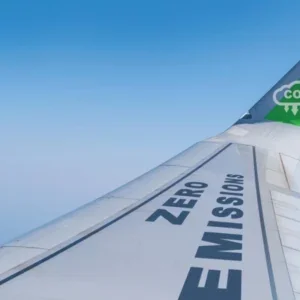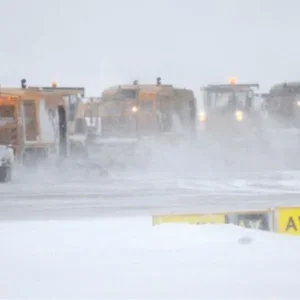Given the relative rarity of severe winter weather in the south of England, it doesn’t seem to take more than an inch or two of snow to severely disrupt flights and make air travellers’ lives a misery at London’s airports. Last December, for example, hundreds of services were delayed or cancelled in and out of Heathrow – this was despite an investment of £10 million for extra snow-clearing equipment and vehicles just a few years before. For BA in particular, de-icing presented a major challenge, resulting in more than 50,000 passengers being left waiting for their flights. Just a few months later, the ‘Beast from the East’ caused some airports across the UK to shut down completely.
A statement issued by Heathrow sounded familiarly ineffectual. The Heathrow spokesperson said, “The safety and comfort of our passengers is always our first priority and we are working closely with our airlines to ensure affected passengers are looked after. We apologise to those whose travel has been impacted and regret the inconveniences that have been caused.”
Northern exposure
Go to Scandinavia, however, and, despite experiencing far more inclement weather conditions for a far longer duration, airports such as Stockholm Arlanda have not had to close because of snow on ice in 50 years. Christian Nyberg is the head of airside and landside maintenance for Swedavia Airports, which owns and operates all ten of Sweden’s airports. He explains, “The reason we at Stockholm Arlanda Airport are able to perform well is mainly due to well-educated staff, in combination with fixed routines, procedures and the possibility to practice in real conditions.”
Looking ahead is crucial, he believes. “Planning is part of our year-round business, but is intensified during the summer months to prepare us for the following winter,” he says. Stockholm Arlanda’s field maintenance team increases from 35 employees in the summer to almost 110 snow clearance employees during the winter season. Five snow clearance teams of 17 to 30 people then work 12-hour shifts, 24/7, between October and April.
Nyberg also highlights the importance of teamwork. “Each winter’s day, there are two scheduled checks to assess the impact of weather on the next 24 hours of operations. There is a twice-daily meeting between the snow supervisor, airport duty manager and the watch supervisor in the tower,” he says.
“When the forecast shows there may be disruptions, a tactical traffic forum meeting is held. Attending are the airport duty officer, the watch supervisor at the LFV control tower, the airport’s snow co-ordinator, traffic planning, the meteorological institute MeteoGroup and ground handling companies. Everyone contributes to keeping the airport operational.”
Smooth Finnish
Making sure staff are well informed is vital. Swedavia has its own training academy that brings new recruits up to speed over the course of three weeks, with the syllabus covering how to use snow and de-icing machines, regular routines, and radio and airport familiarisation, for example. Returning seasonal workers also have to undergo refresher courses. Making up Stockholm Airport’s arsenal of winter weather-fighting equipment are about 100 different snow-clearing vehicles, ranging from sweepers and blowers to ploughs. There are also radar systems, friction test cars, apron cameras, runway surface temperature sensors, as well as GPS tracking and voice communication systems.
It’s a similar picture in Finland. Heini Noronen-Juhola, vice-president of Finavia, which operates 21 airports across the country, is particularly proud of the ‘snow-how’ at Helsinki Vantaa airport, which he says is “always open – 24/7/365 no matter what the weather conditions are”. There can be some delays from de-icing, which is an additional process that needs to be undertaken before take-off, but apart from that, it’s business as usual and prices remain unaffected for airline customers. Safety, of course, is paramount, but, as Noronen-Juhola explains, “Flying is not done in dangerous conditions – in winter, the point of airfield maintenance is to make conditions safe.”
It’s an incredible achievement when you consider that snow typically covers northern Finland for 170 to 200 days a year and southern Finland for about 120 days. The airports keep a close eye on changes in temperature of the tarmac, especially around 0°C, when they know the surface will become icy. This is a particular risk in November and early December. Chemicals can be used to melt the ice if necessary, and, if there has been a period of snowfall, the airport’s army of trucks will be able to clear a runway in as little as 30 minutes.
In February, Reykjavik’s domestic airport experienced 20in of snowfall in just one night. It was the secondbiggest snow event since 21.5in piled up in one go in January 1937 and the airport’s runways completely disappeared under a blanket of white. At the time, press spokesman Guðni Sigurðsson said, “When the airport services started their snow removal duties at between 3am and 4am, they first had to use heat-sensitive cameras to look for the runway lights and use shovels to remove snow from the lights by hand. When they had found the runways, they started working the ploughs. There were some delays to flights, but the airport services did an amazing job in clearing the runways.”
Freeze test
Ensuring flight operations can continue as normal during winter means airlines need to be involved too – it is not just down to the airports. A spokesperson for Swiss says, “We continuously analyse the weather conditions at all our stations and then decide on possible flight operations measures based on the current forecast. During winter months, our base at Zurich can be challenging. However, it is a ‘winter-tested’ airport with a high-quality infrastructure and well-established processes.
“Our station managers provide us with information about the current and expected weather situation at our respective airports. However, there are also situations in which the airport publishes a so-called NOTAM [notice to airmen] on the current weather situation, asking airlines to cancel flights preventively. This often happens when there is heavy snowfall and, therefore, a reduced handling capacity is expected.”
Lufthansa is another airline that can find itself battling the elements during the winter months. How does it collaborate with airports to make sure it can operate when there is snow and ice? A spokesperson says, “Severe winter weather conditions are a regular training condition for our pilots using flight simulators. Lufthansa has its own station manager at most of its airports and any local operational needs and requirements are discussed closely. Of course, if the airport is hit with an unusual weather event, flight irregularities are often related to this. However, our statistics show that winter weather in Western Europe does not generate more delays compared with summer conditions such as thunderstorms.”
With increases in extreme cold weather events arguably becoming more prevalent as a consequence of climate change, particularly in relation to an increase in temperature in the Arctic, it’s imperative for airports and airlines to be prepared. In Europe, it hasn’t just been the UK that has suffered from freak snowfalls. In just a couple of days in December 2017, 400 flights had to be cancelled at Amsterdam Schiphol, along with 300 at Frankfurt and 200 at Brussels airport. Even Rome Fiumicino experienced travel chaos thanks to the Siberian weather system – it had to operate with just one runway after 4in of snow fell in less than four hours.
Always wary of complacency, Swedavia advocates ongoing assessment to boost standards, something many airports around the world could probably learn from. Nyberg says, “Before, during and after the winter, we have meetings every second week with the supervisors of the snow removal teams. We discuss open claims, synchronising our routines and working together with air traffic control. We also have meetings with the handling companies that operate our airport, as well as the biggest airlines and air traffic control centre. Usually these meetings end up with 50–70 actions for improvements.”
De-icing at Munich airport – in numbers
68 aircraft can be de-iced per hour if only frost removal is necessary. It takes longer to remove snow.
25 ‘polar bears’ are available. These are the de-icing vehicles used at Munich.
€10,000 – the amount it costs to de-ice one aircraft.
775,000 litres of Type 4 green de-icing fluid is used every year.
3.2 million litres of Type 1 red de-icing fluid is used every year (64% is used from recycled de-icing fluid).
14,500 aircraft were de-iced in one winter, a record (2012–13).
Source: Lufthansa






